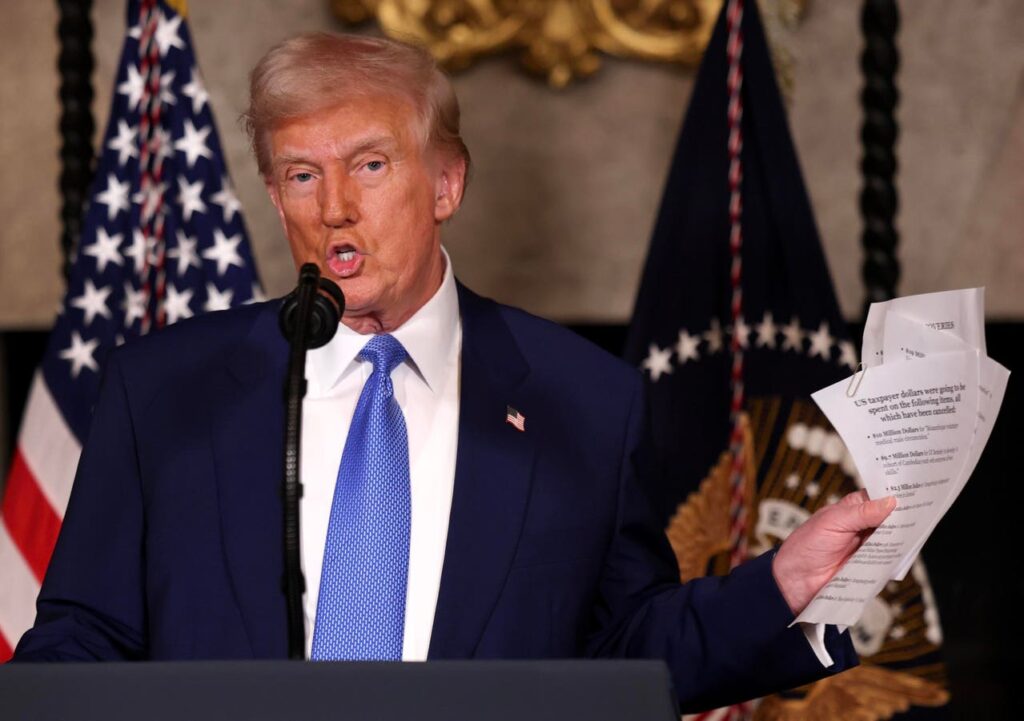Independent agencies’ regulations are now subject to White House review under Donald Trump’s new executive order “Ensuring Accountability for All Agencies.”
PALM BEACH, FLORIDA – FEBRUARY 18:: U.S. President Donald Trump holds up paperwork during a press … [+]
As an accompanying fact sheet states, “… all agencies must … submit draft regulations for White House review—with no carve-out for so-called independent agencies….”
That even executive agency rules, let alone independent ones, have historically received intense, skeptical Office of Management and Budget (OMB) review is, to some degree, a polite fiction. Trump’s order represents a sensible step that has long been advocated by observers of the administrative state. As the administration’s fact sheet reiterates:
“So-called independent agencies like the Federal Trade Commission (FTC), Federal Communications Commission (FCC), and Securities and Exchange Commission (SEC) have exercised enormous power over the American people without Presidential oversight. …These agencies issue rules and regulations that cost billions of dollars and implicate some of the most controversial policy matters, and they do so without the review of the democratically elected President.”
While independent agencies’ rules have not historically been reviewed by OMB, they have been subject to inclusion in the twice yearly Unified Agenda of Federal Regulatory and Deregulatory Actions. They are also subject to the Congressional Review Act’s (CRA) procedures for designating rules that exceed a $100 million threshold as “major.” The CRA provides Congress with a window of 60 legislative days to review a received rule and pass a resolution of disapproval. If issued late enough in the 118th Congress, rules—including those from independent agencies—are subject to being overturned by resolutions of disapproval in the 119th.
Major rules typically add burdens but they can also reduce burdens, delay policy implementation, or set rates and standards for major government programs like Medicaid.
Importantly, major guidance documents—commonly used by independent agencies—are also subject to the CRA but are rarely presented to the GAO or to Congress in a readily trackable manner. In fact, the submission form provided to agencies until 2024 didn’t even note guidance apart from an “Other” checkbox.
Despite the issuance of thousands of rules since the CRA’s passage, only one had been rejected before the first Trump administration (a Department of Labor rule on workplace repetitive-motion injuries in 2001). Currently, fewer than two dozen have been overturned, with most occurring during the Trump administration.
The Unified Agenda, as well as OMB’s annual Report to Congress on regulatory costs can be greatly enhanced by Trump’s broader deregulation drive and its new emphasis on independent agencies, and perhaps boost relevance of CRA controls
The Agenda has long presented agency priorities, detailing rules at various stages in the production pipeline and their economic significance. As seen in the roundup below, which incorporates the fall Unified Agenda released on December 13, the numbers of completed major rules increased considerably during the Biden administration. This makes it an opportune moment for Trump’s new directive to bring independent agencies into the oversight fold, and for lessening the flow and rolling back earlier ones.
Annual Completed Major Rules in the Unified Agenda of Federal Regulations, (Spring plus Fall … [+]
Notable independent agency rules among the 49 Fall Agenda rules in the 2024 column include a Federal Energy Regulatory Commission rule on transmission and interconnection, a Federal Trade Commission rule on regulation of online consumer reviews and several from the Securities and Exchange Commission and from the Consumer Financial Protection Bureau (the latter prominent among agencies in Elon Musk’s Department of Government Efficiency (DOGE) crosshairs. Complete inventories for congressional consideration, with respect to CRA resolutions of disapproval, have been provided elsewhere in this column. Biden rulemakings continued, of course, up to Trump’s inauguration.
The Government Accountability Office maintains a helpful database archive of major rules, thanks to the CRA. While its calendar-year intervals do not always align with the Unified Agenda schedule, and recent tallies will shift as newer rules are added, as of early February the database contained 164 finalized major rules for 2024 (a somewhat higher number than our chart above based on the Unified Agenda).
Recognizing that overlap occurs in transition years, totals and calendar-year averages for major rules across recent administrations, according to GAO’s major rule database, are as follows:
- George W. Bush (eight years): 492 major rules, average 62 rules per year
- Barack Obama (eight years): 675 major rules, average 84 rules per year
- Donald Trump (four years): 345 major rules, average 86 rules per year (includes deregulatory)
- Joe Biden (four years): 464 major rules, average 116 rules per year
Paralleling the bar chart above, Biden’s average annual number of major rules substantially exceeds those of predecessors.
Naturally the focus on the high-cost rule subsets should not distract policymakers and analysts from the remaining bulk of rules in the annual pipeline of over 3,000. Many of these rules have substantial costs and effects in their own right, and many come from independent agencies.
Independent agencies contribute significantly to the regulatory burden but have largely avoided regulatory review. Trump’s new order insists that “For the Federal Government to be truly accountable to the American people, officials who wield vast executive power must be supervised and controlled by the people’s elected President.”
Bottom line: Huge increases in major rules occurred during the Biden era. When progressives are in charge again, large-scale rulemaking by all agencies—including independent ones—will resume unless oversight is permanently strengthened.
An immediate priority, therefore, is for Congress to step up and codify the inclusion of major rules in the review and oversight structure. That way, Trump’s innovation of finally “Ensuring Accountability for All Agencies” will not be overturned when the next shift in power occurs.
Read the full article here
